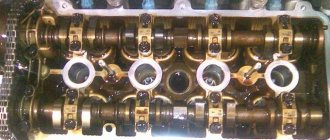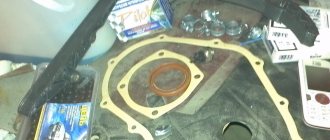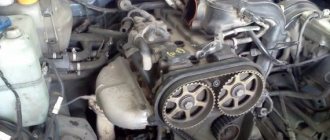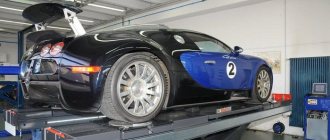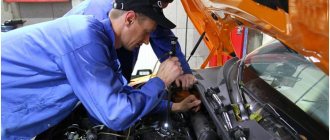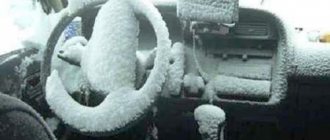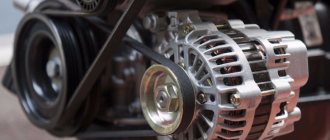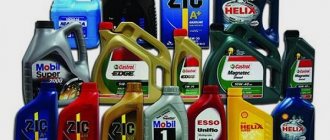One of the proven methods for diagnosing the operation of most car systems is audio monitoring. You can often simply hear about engine malfunctions after turning on the engine from the engine compartment area. Most drivers do not worry if hydraulic compensators knock when cold, especially when the undesirable effect disappears after warming up.
The unpleasant phenomenon can also return on a warm engine. In this situation, it is not recommended to ignore the problem, since it can lead to undesirable consequences in the near future.
Identifying the cause of extraneous noise
Hydraulic compensators (HCs) used in internal combustion engines help adjust the thermal gap automatically. This design solution helps simplify the operation of the power plant. An additional advantage is the increased service life of the gas distribution system.
Experienced engine mechanics identify the following main reasons for knocking hydraulic compensators:
- manifestation of problems with the vehicle’s lubrication system;
- physical depletion or breakdown of the main battery;
- discrepancy between the physical and chemical parameters of the motor oil used in the car or loss of its performance characteristics.
It is important to consider that a decrease in the performance of the timing belt can be associated simultaneously with several negative reasons.
The hydraulic fluid used in the engine operates on the principle of a plunger pair, which interacts with the engine oil. Over a long period of operation, the metal surfaces of the assembly in contact with each other are subject to mechanical wear, which leads to wear and other types of loss of geometric shape.
The resulting contamination can cause unwanted hanging of the valves that supply oil to the compensators. This incapacitates them. It is also possible that there may be jamming or complete breakdown, or air entering the system due to insufficient oil .
Drivers are often interested in whether hydraulic compensators can knock due to oil. The answer will be in the affirmative, because the quality of the lubricating motor fluid determines the performance characteristics, which include the following parameters:
- compression ratio;
- foaming;
- viscosity;
- seasonality;
- matching the motor type, etc.
Failures in the lubrication system lead to air pollution. The penetration of air bubbles is also associated with a reduced level of oil pressure in the channels. As a result, the presence of gas changes the possibility of compression. Air can also penetrate if the level of lubricating fluid overflows, which, due to the increased volume, foams at the oil pump and can damage the latter.
The reason why hydraulic compensators knock when hot may be excessive contamination of the lubrication system, which allows debris and deposits to penetrate into the hydraulic fluid. The culprit of what is happening turns out to be a clogged oil filter, which provokes the opening of bypass valves through which the working fluid is not filtered.
Additional negative factors include the following events:
- penetration of antifreeze into the lubrication system;
- there is an excess of crankcase gases with the oil;
- Fuel, etc., penetrates into the lubricating fluid.
In such cases, the main characteristics of the working fluid are lost.
Design and principle of operation of hydraulic compensators
The device of a standard hydraulic compensator is represented by a housing with a movable plunger pair inside, which includes a spring-loaded plunger with a ball valve and a bushing. The housing can be a part of the cylinder head, a cylindrical pusher, or elements of valve drive levers.
The operation of the hydraulic compensator largely depends on the plunger pair. Thanks to a gap of 5 - 8 microns between the plunger and the bushing, on one side the connection is completely sealed, and on the other side the parts move freely relative to each other.
A check ball valve closes the hole in the bottom of the plunger, and a spring of the required stiffness is installed between the plunger and the bushing.
The operating principle of hydraulic valve compensators is discussed in more detail below:
- The thermal gap remains between the camshaft and the housing at the moment when the camshaft cam is positioned with its back side towards the pusher.
- Through the oil channel, oil enters the plunger from the lubrication system, and at the same time a spring acts on the plunger and lifts it, compensating for the gap. Oil also enters the cavity under the plunger.
- As the shaft turns, pressure is exerted on the follower from the cam side, causing it to move downward.
- The check ball valve closes, and the plunger pair takes on the role of a rigid element, transmitting force to the valve.
- A little oil is squeezed out from under the plunger because there is a gap between it and the bushing, but since the oil comes from the lubrication system, the leakage is compensated.
- The length of the hydraulic compensator changes slightly because the parts heat up when the engine is running, but the gap is automatically compensated by changing the volume of the oil portion.
This is interesting: How to change the silent blocks of the front control arms on a Skoda Octavia A5
The hydraulic compensator rattled: what should I do?
During the diagnostic process, it is necessary to pay attention to the ability of the valve to hold pressure. Otherwise, an oil leak will form when the engine is turned off and an air bubble will form. After the start, the oil volume displaces the gas, which helps eliminate the consequences - knocking - and return to normal operating mode.
It usually takes several minutes to warm up and squeeze out the air. Sometimes applying the accelerator pedal helps speed up the elimination of unwanted sound, but this should only be done with a warmed-up internal combustion engine stopped for a short period.
It is important to know that in some cases, changing the brand of oil to a more viscous one helps get rid of leaks, but in critical situations, only repairing the power plant or completely replacing the hydraulic system can save you.
A clogged channel for liquid lubricant becomes clogged due to the appearance of carbon deposits and mechanical impurities. Warming up the engine helps to liquefy dirt and deposits, after which the tapping goes away on its own. For such cases, experienced motorists use restorative cleaners in the form of additives to the liquid.
Checking the oil filter when knocking is detected when cold will help determine the throughput of the unit. Only a low-viscosity, well-heated liquid can penetrate through the clogged surface, so you have to wait for the engine to warm up. This ensures better oil passage and eliminates knocking noises. The system will be helped by flushing or switching to a new type of oil.
Debugg
Since there are several hydraulic compensators in a car, it is worth using acoustic diagnostics to determine the faulty one. An experienced technician knows how to check hydraulic compensators for functionality using acoustic diagnostics, that is, sound.
For an experienced master, such manipulations are not difficult. After identifying the problematic hydraulic compensator, to eliminate the knocking, it is necessary to wash it, return it to its place and restart the engine. If this measure does not help, you will have to replace it. Let's consider step-by-step actions in the case of both procedures.
How to wash the hydraulic compensator?
The mechanism in question must be washed in a room protected from dust and drafts. It won’t be possible to not disassemble the engine at all, but there is also no need to rid it of every screw.
At the preparatory stage, prepare three deep containers the size of the compensator, as well as a flushing liquid, which can be kerosene or good 92-grade gasoline.
Also, before washing, leave the car in the garage for a day to allow as much oil as possible to drain into the pan. Further actions are as follows:
- Disconnect the battery to de-energize the car.
- Get rid of the air filter.
- Remove the bolts to remove the cylinder head cover.
- Remove the hydraulic compensator from its sockets after removing the rocker arm axles.
- Use a synthetic bristle brush to clean the outside of parts.
- Wash the hydraulic compensators in the first container. To do this, immerse each of them in the liquid and press the ball valve through the hole in the plunger using a wire. Be careful not to break the spring. Next, press the plunger itself. As soon as you notice that the movement has become easier, carefully squeeze out the valve ball and drain the fluid from the compensator. Use a syringe to additionally rinse the channels in the body and proceed to a similar rinse in the second container.
- At the final stage, you will be tested; for this you will need a third container with flushing liquid. How to check hydraulic compensators before installing them in place? It is enough to dip them into the third container, draw liquid into the HA and lower the valve, then remove the part with the plunger up. If you press the plunger with your finger, it should not move.
- If there is no movement, return the parts to their place by installing the rocker arms, cylinder head cover and other elements. Remember to tighten the bolts from the middle to the edges.
This is interesting: The principle of operation of the transfer case, types, purpose
After the assembly is completed, start the engine and wait a couple of minutes until it idles, at which there should be no knocking after flushing. Cleaning also helps get rid of knocking after the engine warms up and reaches operating temperature.
Replacing the hydraulic compensator
If cleaning does not help, replacing the hydraulic compensators will be the only reasonable solution. The procedure for replacing hydraulic compensators is as follows:
- Remove the faulty mechanism using a puller or magnet. The latter method is advisable only when the hydraulic compensator moves freely. If it is stuck to the outer surface, only a puller will help.
- Wash the entire oil supply system, replace the oil filter and fill in new oil, check its supply to the seat of the compensators by turning the crankshaft. The hydraulic compensator should already be removed.
- It is strictly prohibited to install expansion joints without oil, otherwise critical shock loads will occur.
- After installing the new mechanism in its seat, do not start the power unit immediately. Use the wrench to turn the crankshaft a few turns and wait half an hour. During this time, the parts will find their jobs, and the internal pressure will normalize.
Since one or several hydraulic compensators can fail, you will have to decide for yourself how many of them to replace. In this case, the decisive factor is the financial situation. If there are dismountable mechanisms, repair and maintenance of each one separately is possible.
If you prefer a comprehensive replacement, this solution will be optimal and will give you a guarantee that there will be no problems in the near future. Never skimp on the quality of the oil, which will allow you to significantly extend not only the service life of the compensator, but also the rubbing elements of the engine.
Manifestation of negative noises “on hot”
It is believed that the occurrence of extraneous sounds from hydraulic pushers after the internal combustion engine has warmed up is a more dangerous factor. The noise may increase as the temperature increases, and may also remain at idle or occur under load. The number of reasons will be considerable.
At the initial stage, you should make sure that the sound comes from the hydraulic compensators, because the source can be any working unit. Next, it’s worth determining which hydraulic compensator is knocking, which will allow you to localize the problem. To do this, a number of actions are performed:
- Press on the selected main body with a drift made of soft metal, for example, copper, bronze or brass. In this case, the fist from the crankshaft must be turned with its back side towards the compensator.
- The normal operating condition is that significant force will be required when pressing. Otherwise, with a small yielding load, it will be necessary to replace the exhausted HA.
- Alternately, we position the camshaft knuckles with the highlighted part facing up and test the resulting gap. To do this, we use a wooden wedge, sinking each element in turn and measuring the speed of movement.
- If we detect a significantly increased speed compared to the others or if there is a large gap, we dismantle the problematic hydraulic pusher or clean and diagnose it.
How does knocking occur?
A fully serviceable engine, filled with the appropriate type of lubricant, does not make any extraneous sounds during operation, since the gaps in all mechanisms are minimal. The clicking sound of hydraulic compensators coming from under the valve cover indicates the following: an increased gap has appeared between the cam and the plane of the pusher. When the camshaft turns, the convex working part hits the surface of the compensator, producing a loud click.
Article on the topic: How to make a battery charger with your own hands?
Knocking hydraulic pushers are not a disaster, although driving with such a sound is not very pleasant. However, it is better to quickly identify the source of the problem and fix the problem. What threatens the increase in thermal gaps:
- intake and exhaust valves do not open completely, which impairs engine performance as a whole;
- wear of expansion joints accelerates;
- wear appears faster on the convex surfaces of the camshaft;
- the inside of the valve plate and the stem are covered with carbon deposits.
Reference. Hydraulic compensators of passenger car power units are not repaired, only replaced. Parts are sold in sets of 8 and 16 pieces. (depending on the number of valves), it is not possible to buy 1 pusher separately.
How to accurately diagnose which hydraulic compensator is knocking
If the knocking is constant, then it is necessary to determine where exactly the problem lies. For this purpose, in most cases, acoustic diagnostics are used using a special device.
You can check the hydraulic compensators directly, for which you will need a wooden block. To perform the check, you need to provide partial access to the hydraulic compensators by removing the valve cover. Then you need to press one by one on the bottom of each hydraulic compensator. It is important that they are not pressed by the camshaft cam. After applying force, the hydraulic compensator will be recessed into the seat. If it is jammed, then it will not be possible to drown it, since the valve spring will not allow this to be done. And in case of insufficient oil supply, the hydraulic compensator will be recessed much easier than others.
